StrandVision Digital Signage
715-235-SIGN (7446) | www.StrandVision.com
- Home
- News & Events
- In The News
- Heavy-Duty Digital Signage
Heavy-Duty Digital Signage
StrandVision breaks new ground in the construction world.
May 1, 2006 12:00 PMBy Daniel Keller
As digital signage technology has begun to come of age, much has been written about this unique business marketing tool and its immense potential. Articles by this writer and dozens of others have profiled a wide range of interesting and unique applications for these electronic display networks, from trade shows and movie theaters to supermarkets and fast food outlets. To adopt the nomenclature of Geoffrey Moore's classic Crossing the Chasm, digital signage technology seems to be making the transition from the "early adopter" stage, embraced by a small handful of innovators and technology freaks, to the "early majority" phase, with a growing awareness of the products and their range of possibilities. Until now, much of the market for digital signage has been focused on high-tech and mass consumer markets. But recently, the technology has begun to find its way into some unexpected arenas, with surprisingly effective results.
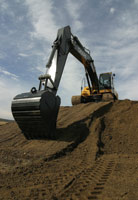 |
One such case is that of Nortrax, a heavy-duty construction and forestry equipment dealer and a subsidiary of John Deere. With more than 1,000 employees in approximately 48 locations in 18 states, it's the largest John Deere dealership group in the world. Stacey Curtis is the marketing director for Nortrax's Midwest regional offices, representing northern Wisconsin, northern Minnesota, and the upper peninsula of Michigan. Her division recently has begun implementing a digital signage network in its dealerships in the region, using an Internet-based distribution system pioneered by Eau Claire, Wis.-based StrandVision.
"Tim Murphy, our regional vice president, met Mike Strand, StrandVision's founder and president, at a trade show, and was really intrigued by the technology and how Nortrax could get involved with it," recalls Curtis.
Strand adds, "Tim's a pretty forward-thinking individual, and he saw our system as something of an outside-the-box solution for getting their message out. We both knew up front that Nortrax wasn't the typical customer for digital signage, but I think we're both the kind of people who like a good challenge." After meeting to discuss some of the details, Nortrax decided to do a trial run in its local dealership area.
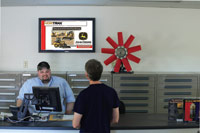 By expanding its services into a market not traditionally identified with the technology, StrandVision found an effective new application for digital signage in a heavy equipment dealership. By expanding its services into a market not traditionally identified with the technology, StrandVision found an effective new application for digital signage in a heavy equipment dealership. |
Initial setup of the StrandVision system was relatively painless, recalls Mike Amoe, IT manager for Nortrax's Midwest region. "The componentry is all pretty generic stuff — a Windows PC and one or more plasma displays," he says. "The StrandVision systems were all up and running with no real issues." Because the system requires only a standard Internet connection, the demands in terms of resources are relatively small.
"A lot of our dealerships are in more rural areas, and part of the initial setup involved making sure those locations had good, dependable broadband feed," Curtis says. "Other than that, it was a pretty straightforward process."
Once the network is online, customizing content to fit each location's needs is also a simple procedure. As Curtis explains, with administrator-level access, she can log onto the StrandVision website and specify the target of each piece of collateral material, whether it be globally across the network, for a single store, or for a regional group of dealers.
"The majority of content is slated for the entire network, but there are always a few items that might be targeted for a specific location or region that's running a special. In some cases, we might have a dealership that's got a large stock of a specific item, or another store [that is] out of stock, and it's a tremendous advantage to be able to go in and quickly change each location's display to reflect that. As the network expands, this will probably be even more the case."
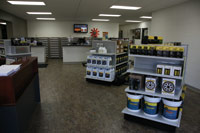 StrandVision’s digital signage system makes customizing content to fit individual locations’ needs a simple procedure. Users with administrator-level access can log onto the StrandVision website to specify the target of each piece of material: globally across the network, for a single store, or for a regional group of dealers. StrandVision’s digital signage system makes customizing content to fit individual locations’ needs a simple procedure. Users with administrator-level access can log onto the StrandVision website to specify the target of each piece of material: globally across the network, for a single store, or for a regional group of dealers. |
As Strand explains, the StrandVision approach is somewhat unique in that it uses an open, Internet-based approach to content distribution. The display is typically an Electrograph DTS4225PTD 42in. plasma, a Samsung PPM42M5H, or a Sony PlasmaPro PFM-42X1B 42in. plasma, and users provide their own Windows-based PC. "What makes StrandVision a bit different is that by using a simple web-based distribution system, we're able to offer a lower-cost solution than closed, standalone systems," Strand says. "We do recommend our customers use a dedicated PC for the system, but other than the computer and the displays, there's a really minimal investment. A standard system runs $55 per month for the first location and $29.95 per month for additional locations. We keep the cost low by not using a lot of bandwidth."
At present, Nortrax is using only still imagery on its narrowcast network, but that situation is slated to change. "We've got a considerable archive of great video footage," Curtis says, "for example, video trailers showcasing new John Deere equipment, or showing some of our existing equipment in competition with comparable equipment from competing manufacturers. We're in the midst of securing approval at the corporate level to utilize this content on the signage network."
In the Nortrax environment, as with many applications, audio is not an important aspect of the digital signage technology. "A heavy equipment dealership, by its nature, is not the quietest of environments," Curtis says. "For the most part, having sound playing would probably be more of a distraction than a benefit."
While adding streaming video and other animated content places a slightly higher set of demands on the network, as Strand points out, that demand is still minimal overall. "At its most basic, the bandwidth of a typical signage network is commensurate with that of a PowerPoint presentation," he says. "Adding video streaming capability is a bit more data intensive, but certainly nothing today's standard broadband connections can't handle. Incorporating these more data-intensive features represents a very modest cost, and one that is easily recouped via any number of business models."
Of course, the StrandVision network is designed to meet the highest standards of dependability and security. "The StrandVision system uses its own dedicated server with secure connection and multiple layers of password protection," Strand says. "We've spent a considerable amount on setting up a dedicated web server network designed to handle a million users simultaneously. All confidential data is encrypted, with multiple levels of authorization, multiple levels of directories, and lots of redundancy."
There are other advantages to StrandVision's web-based approach as well. "Because we're Internet-based, we can gather lots of useful data and keep our content localized, fresh, and interesting," he explains. "We can easily integrate value-added content, like web-based news and weather feed. A lot of the Nortrax customers, for example, spend a good part of their time outside, and we found they really appreciate seeing that weather information."
 The signage systems were easy to install according to Mike Amoe, IT manager for Nortrax’s Midwest region, requiring only generic componentry—usually Electrograph DTS4225PTD, Samsung PPM42M5H, or Sony PlasmaPro PFM-42X1B plasmas in addition to users’ own Windows-based PC. The signage systems were easy to install according to Mike Amoe, IT manager for Nortrax’s Midwest region, requiring only generic componentry—usually Electrograph DTS4225PTD, Samsung PPM42M5H, or Sony PlasmaPro PFM-42X1B plasmas in addition to users’ own Windows-based PC. |
A primary issue that needed to be addressed at the outset was how best to employ the technology in what was a relatively untried environment. As Curtis observes, dealing in heavy industrial equipment appeals to a specialized strata of customer base and calls for an exceptionally different marketing focus than that of, say, your average mall-going shopper. "Generally speaking, our stores are not flashy and exciting on a level with more mainstream retail," she says. "There's a much different strategy in marketing a tractor or a can of oil than there is to hawking the latest brand of designer jeans."
But the fact that the Nortrax retail outlets are probably more on the level of an auto parts dealer than a fashion center can actually make the use of digital signage all the more effective. "The typical shopper at a clothing store is probably so accustomed to being inundated by music videos on multiple monitors that they tend to tune it out after a while," Curtis states. "Our customers are not as jaded, not as used to seeing this kind of display technology — and a bright, crisp video display with non-static content behind the parts counter really catches their attention."
That said, Curtis is quick to point out that it's not simply a matter of dazzling customers with glitzy displays. "Our customers may not be involved in the technology sector on a daily basis, but they're far from Luddites," she says. "These are people working with high-tech vehicles and machinery on a regular basis. They've got laptops and fairly elaborate communication in the field. They're more high-tech than you might think."
Indeed, while most of us outside the construction and forestry communities may only know the company for its tractors, John Deere has a lengthy history of innovative technology development and a commitment to raising standards for logging and construction technology. "These are engineers, and John Deere provides them with cutting-edge equipment," Curtis asserts. "Providing our customers this level of display technology in our stores makes us all look like the professionals we are."
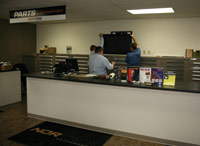 After some initial skepticism about the system on the part of dealers—at least one dealership tried to send the installers away—more and more dealerships are inquiring about the signage because of the positive effect it’s had on sales. The signage keeps customers informed and generates curiosity about specials. After some initial skepticism about the system on the part of dealers—at least one dealership tried to send the installers away—more and more dealerships are inquiring about the signage because of the positive effect it’s had on sales. The signage keeps customers informed and generates curiosity about specials. |
From a visual perspective, Curtis admits she also had some initial reservations. "We create a lot of collateral marketing pieces, such as brochures, flyers advertising monthly specials, and other printed media," she explains. "I'm pretty particular about image quality, and a lot of the low-resolution stuff I'd seen looked far too pixelated. I create most of my images for print, and I was concerned that it wouldn't translate well to the video display."
Strand and his staff worked with Curtis to address image quality issues such as resolution, sizing, and coloration, moving between several different programs to find the simplest and most effective solutions. "I typically create our content in Illustrator or Quark Express," she says. "We found that taking those completed images into Photoshop and working with them in PNG file format has been a great way to retain the quality and aspect ratio. I thought it would be a nightmare, but it's really been pretty simple to adapt, and the results have been far better than I would have expected."
A PROMISING BEGINNINGAs with the introduction of any new technology, there was an adjustment period, particularly with the users in the field. "These are parts guys, not IT professionals, and the initial reception from some of them was somewhat skeptical," Curtis says. "I think at least one dealership tried to send the installers away when they first showed up. But StrandVision created a setup that really requires no effort on their parts other than to turn on the computer in the morning. And now they've seen what a positive effect it's had on their sales, more and more dealerships are inquiring about it."
Indeed, as Strand observes, the results have been both positive and immediate. "Within a very short time they had sold an industrial fan, which I think pretty much paid for the subscription in one location for about a year," he says.
Curtis agrees, "We're always running monthly service promotions and parts specials, as well as creating informational and educational content, and this technology is proving to be a tremendous asset in getting that information out to our customers. And our parts guys are typically pretty busy, so having the signage as a tool to inform the customer about a special takes the onus off the parts guys to constantly push that information. Instead, the customer sees it and asks about it. It keeps our parts guys on their toes and results in better sales."
Curtis also gives the StrandVision partnership high marks. "The guys over there have been really proactive," she says. "They check in with us on a regular basis, and really listen to our feedback. I was going on vacation for a couple of weeks and had some specials that needed to be uploaded while I was away, and Mike went ahead and implemented a calendar-based scheduling program so I could upload content a month in advance." She adds with a grin, "Now if I only had time to get that far ahead."
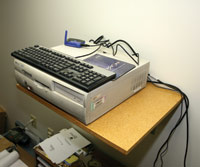 The systems installed in the Nortrax dealerships use standard Internet connections and require little employee effort beyond turning on the computer in the morning. The systems installed in the Nortrax dealerships use standard Internet connections and require little employee effort beyond turning on the computer in the morning. |
As Nortrax has been entertaining the potential of growing the StrandVision model throughout the entire chain, StrandVision is looking at other enhancements to the installation process. "Our long-term mission includes setting up a channel of systems integrators across the country and internationally," Strand says. "One thing that kind of surprised us is that NSCA integrators are not well supplied by manufacturers with leads and other support material. We know that to be successful, we need to make the integrators' jobs easy and profitable."
"Part of our philosophy is to move away from the norm and seek out the more unconventional and unexpected markets," he continues. "We've identified 15 to 20 markets we think represent good opportunities — markets that are not traditionally the ones identified with this type of technology."
The economics of implementing the digital signage network are easily adapted to any number of potential scenarios, Strand points out. "There's a tremendous range of possibilities in employing the technology, and a wide range of business models to make it pay for itself," he says. "For example, some of our customers are electrical or plumbing contractor houses, where they have their suppliers paying in the range of a couple of hundred dollars monthly for advertising space on their displays. That advertising revenue pays for the system several times over, and from the suppliers' point of view it's an incredible value. They get access to a specific, pre-qualified audience in a focused environment, for a fraction of what a local TV ad would cost."
As Strand knows from his background as a software engineer, the technology itself is still in its nascent days. "A big part of the approach is to keep the system simple and portable for maximum flexibility," he says. "We're experimenting with a number of new models in user interfaces. For example, in the case of some outdoor-based industries, we're looking at a system where different weather temperatures might activate different types of advertising. For other systems we're working with using RSS feeds based on user-programmed keywords to bring up specific pages. We'll also be implementing a stock market-based model, where certain stock shares' price changes are earmarked to bring up vendor ads. The possibilities are practically unlimited.
"It's all about giving our customers the ability to come up with new and profitable ways to serve their markets."
For More Information
Electrograph
www.electrograph.com
Samsung
www.samsung.com
Sony
bssc.sel.sony.com
StrandVision
www.strandvision.com